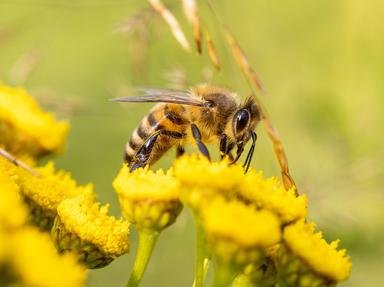Quiz Answer Key and Fun Facts
1. Honey bees seem to be flying everywhere, collecting nectar and pollen and making delicious honey. Have you ever wondered why honey bees are in the United States and North America?
2. You've probably seen on news reports where beekeepers are called in to capture a swarm of honey bees. Have you ever wondered why honey bees swarm?
3. A honey bee has wings and flies to collect nectar and pollen. What is a honey bee's basic classification?
4. During the summer of 2010, I saw only one honey bee flying around collecting nectar and pollen. What is the most likely cause of the disappearance of the honey bee throughout the United States?
5. What is the name for the science of beekeeping?
6. A honey bee has collected nectar and now flies off, heading for home. What is the name of the home for a honey bee?
7. If you see a honey bee collecting nectar and pollen you know there is a hive within how many miles?
8. The art and science of beekeeping has a long history. What peoples were the first to domesticate and keep honey bees?
9. Honey bees have harvested nectar and pollen, flown to their hives and made honey. Beekeepers have harvested the honey and processed it for sale to you, the consumer. What is the most common honey found on supermarket shelves in the USA?
10. Western honey bees do fly everywhere. Of concern, however, are hybrids known as 'killer bees' which migrated to the United States in 2002. What is this aggressive hybrid honey bee known as?
Source: Author
MtnGuy1954
This quiz was reviewed by FunTrivia editor
guitargoddess before going online.
Any errors found in FunTrivia content are routinely corrected through our feedback system.
